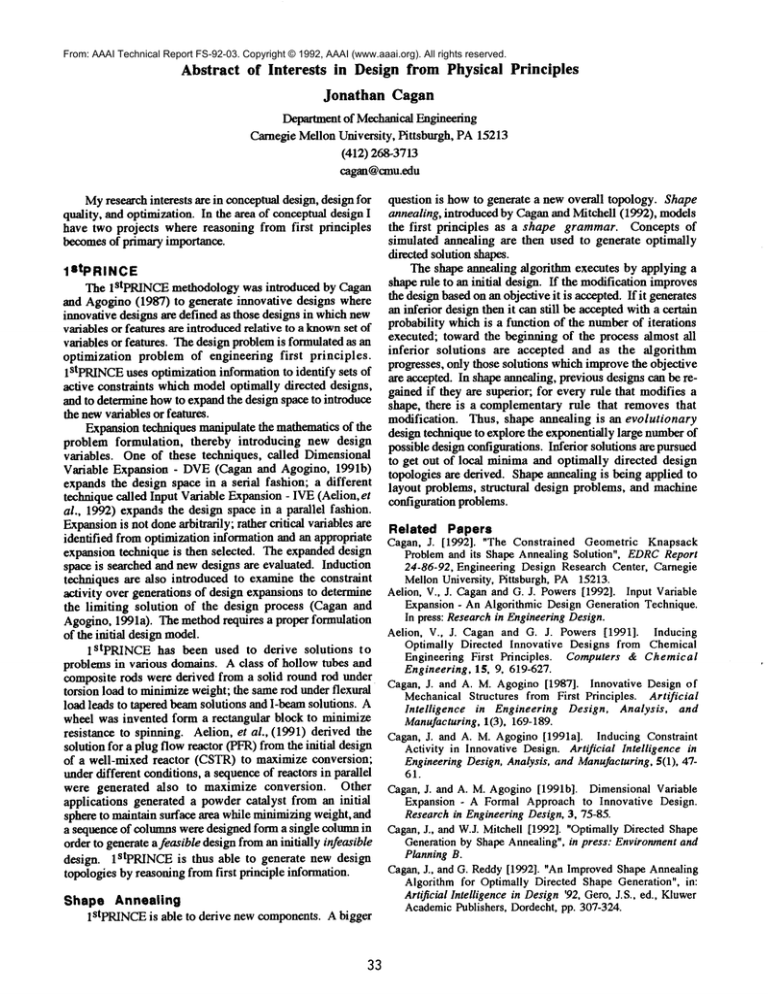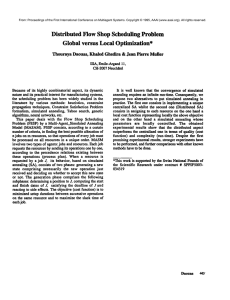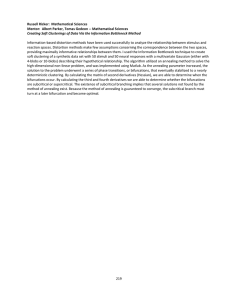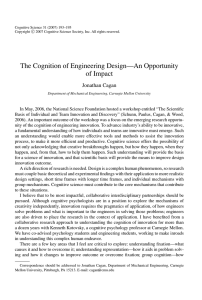
From: AAAI Technical Report FS-92-03. Copyright © 1992, AAAI (www.aaai.org). All rights reserved.
Abstract of Interests
in Design from Physical Principles
Jonathan Cagan
Departmentof Mechanical Engineering
Carnegie Mellon University, Pittsburgh, PA15213
(412) 268-3713
cagan@cmu.edu
Myresearch interests are in conceptualdesign, design for
quality, and optimization. In the area of conceptual design I
have two projects where reasoning from first principles
becomesof primary importance.
lStpRINCE
The 1StpRINCEmethodology was introduced by Cagan
and Agogino (1987) to generate innovative designs where
innovative designs are defined as those designs in which new
variables or features are introduced relative to a knownset of
variables or features. The design problemis formulatedas an
optimization problem of engineering first principles.
lStpRINCE
uses optimization information to identify sets of
active constraints which model optimally directed designs,
and to determine howto expandthe design space to introduce
the newvariables or features.
Expansion techniques manipulate the mathematics of the
problem formulation, thereby introducing new design
variables. One of these techniques, called Dimensional
Variable Expansion - DVE(Cagan and Agogino, 1991b)
expands the design space in a serial fashion; a different
technique called Input Variable Expansion- IVE (Aelion, et
al., 1992) expands the design space in a parallel fashion.
Expansionis not donearbitrarily; rather critical variables are
identified from optimization information and an appropriate
expansion technique is then selected. The expanded design
space is searched and new designs are evaluated. Induction
techniques are also introduced to examine the constraint
activity over generations of design expansions to determine
the limiting solution of the design process (Cagan and
Agogino, 1991a). The methodrequires a proper formulation
of the initial design model.
l stpRINCE has been used to derive solutions to
problems in various domains. A class of hollow tubes and
composite rods were derived from a solid round rod under
torsion load to minimizeweight; the samerod under flexural
load leads to tapered beamsolutions and I-beam solutions. A
wheel was invented form a rectangular block to minimize
resistance to spinning. Aelion, et al., (1991) derived the
solution for a plug flow reactor (PFR)from the initial design
of a well-mixed reactor (CSTR) to maximize conversion;
under different conditions, a sequenceof reactors in parallel
were generated also to maximize conversion. Other
applications generated a powdercatalyst from an initial
sphere to maintain surface area while minimizingweight, and
a sequence of columnswere designed form a single columnin
order to generate a feasible design froman initially infeasible
design, lstpRINCE is thus able to generate new design
topologies by reasoning from first principle information.
Shape Annealing
lStpRINCE
is able to derive newcomponents.A bigger
33
question is how to generate a new overall topology. Shape
annealing, introduced by Caganand Mitchell (1992), models
the first principles as a shape grammar. Concepts of
simulated annealing are then used to generate optimally
directed solution shapes.
The shape annealing algorithm executes by applying a
shape rule to an initial design. If the modification improves
the design based on an objective it is accepted, flit generates
an inferior design then it can still be acceptedwith a certain
probability which is a function of the numberof iterations
executed; toward the beginning of the process almost all
inferior solutions are accepted and as the algorithm
progresses, only those solutions which improvethe objective
are accepted. In shape annealing, previous designs can be regained if they are superior; for every rule that modifies a
shape, there is a complementary rule that removes that
modification. Thus, shape annealing is an evolutionary
design technique to explore the exponentially large numberof
possible design configurations. Inferior solutions are pursued
to get out of local minima and optimally directed design
topologies are derived. Shape annealing is being applied to
layout problems, structural design problems, and machine
configuration problems.
Related Papers
Cagan, 2. [1992]. "The Constrained Geometric Knapsack
Problem and its Shape Annealing Solution", EDRCReport
24-86-92, Engineering Design Research Center, Carnegie
MellonUniversity, Pittsburgh, PA15213.
Aelion, V., J. Caganand G. J. Powers[1992]. Input Variable
Expansion- An Algorithmic Design Generation Technique.
In press: Researchin EngineeringDesign.
Aelion, V., J. Cagan and G. J. Powers [1991]. Inducing
Optimally Directed Innovative Designs from Chemical
EngineeringFirst Principles. Computers & Chemical
Engineering, 15, 9, 619-627.
Cagan, J. and A. M. Agogino [1987]. Innovative Design of
Mechanical Structures from First Principles. Artificial
Intelligence
in Engineering Design, Analysis, and
Manufacturing,1(3), 169-189.
Cagan, J. and A. M. Agogino [1991a]. Inducing Constraint
Activity in Innovative Design. Artificial Intelligence in
EngineeringDesign, Analysis, and Manufacturing,5(1), 4761.
Cagan, J. and A. M. Agogino[1991b]. Dimensional Variable
Expansion - A Formal Approach to Innovative Design.
Researchin EngineeringDesign, 3, 75-85.
Cagan,J., and W.J. Mitchell [1992]. "OptimallyDirected Shape
Generation by Shape Annealing", in press: Environmentand
Planning B.
Cagan, J., and G. Reddy[1992]. "AnImprovedShapeAnnealing
Algorithm for Optimally Directed Shape Generation", in:
Artificial Intelligence in Design’92, Gero, J.S., ed., Kluwer
AcademicPublishers, Dordecht, pp. 307-324.







